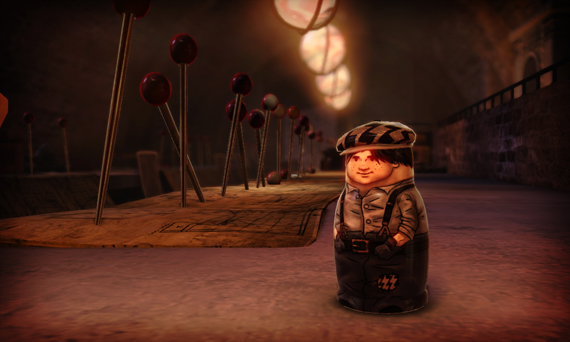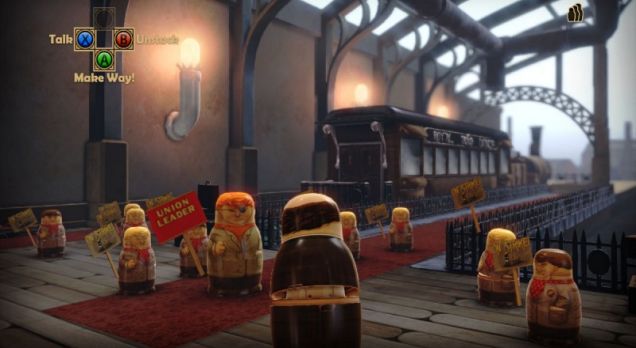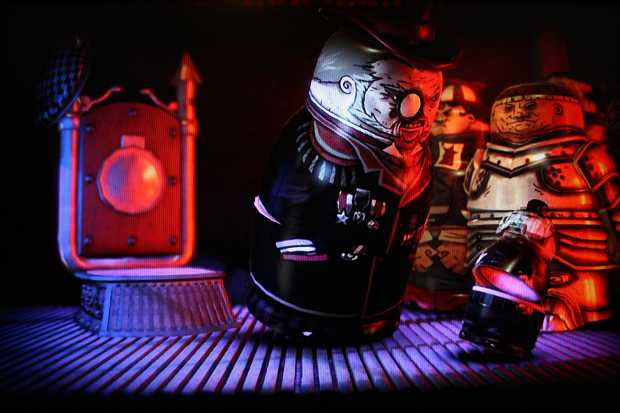Stacking is the latest downloadable offering from Double Fine, and like its predecessor Costume Quest it’s an imaginative if very easy-going puzzle game with a whole load of style but not much in the way of substance. The premise is instantly striking – just like in Costume Quest (a phrase I can see myself using a hundred times in this review, so let’s shorten it to ‘JLICQ’ for brevity’s sake), the player takes control of a young child on a mission to rescue their sibling(s), but this time it’s not suburban Americana in the spotlight – it’s the far more interesting and surreal world of 1920s Russia, populated entirely by matryoshka dolls and filtered through the visual and audio stylings of early silent cinema.
It’s a wonderfully constructed setting. The tinkling music hall piano and faded film (which periodically slips off the track revealing sprocket holes to the light of the projector) fit the tone very well; the slightly creepy but authentically recreated painted faces on the dolls all perfectly evoke the time period, as does the card-and-wire animation in the ‘special effect’ segments, although sometimes the dialogue presented on classic title cards slips into overly modern language and lets it down somewhat. This, though, is a minor complaint given the success with which the rest is implemented.
Two things in particular make the setting feel really special. Firstly, the amount of creativity that has gone into imagining how a world populated with matryoshka dolls would work: little touches like all the doorways having multiple doors of ascending scale contained within them to create the right frame for each size doll to fit through add up to create a constantly involving and interesting setting. The star of the show for me, though, is the subject matter. The plot is conveyed in a simplistic and child-friendly manner, but deals with mature issues like unions and worker’s rights, class divide and child labour, and having such a tale played out by these wooden fixed-expression toys creates a perfectly unique, strangely unhinged atmosphere. It reminds me of that strange but wonderful English tradition of children’s fiction that focuses on the really nasty stuff but in a way that suits a young mind; it’s a rich vein of fiction that Stacking mines well.
Unfortunately, all that good stuff is in the visual aesthetic and cut-scenes. The game itself is just about the dullest thing I’ve played in living memory. JLICQ, the puzzles all boil down to the same thing – find the costume nee doll which has the ability you need, use the ability in the right place, and you’re done. It’s never hard, just time consuming and long-winded. It really is near-identical to Costume Quest minus the battles, which I find particularly puzzling given the conceit that Double Fine are using these downloadable titles to explore their creativity and take risks. Nothing says creativity and risk-taking like releasing the same boring game twice!
JLICQ every single level is identical, meaning the stuff you enjoyed because it was a nice idea in the first level is monotonous in the second, third and fourth level, because it’s exactly the same, and it wasn’t that fun to begin with. An example: in the first level of Stacking you find a family who have become lost and separated in the train station. To reunite them you must locate the smallest family member and jump into them. From there you locate the next biggest and ‘stack’ into them, then the next biggest and so on until you’ve reached the last and largest member of the family. It’s a good idea, because it plays well with the stacking theme, literally reuniting the family by putting them back together again. “What a great idea”, I thought. Then came level 2, and all those Costume Quest memories came flooding back. It’s only fun because the concept is great: doing it multiple times adds nothing. Worse, when you do it multiple times you start to see the flaws. Like how all the family members wander around the map randomly, so finding them doesn’t involve any actual gameplay, just wandering around randomly yourself until you happen to see them, all the while struggling with the outdated and imprecise movement associated with PlayStation-era 3D games played with the analogue sticks but designed for the ill-suited D-Pad.
The puzzles themselves are entirely uninteresting. You will be given an end goal (example: “Disrupt the dinner service on the cruise liner”) and then be told how many different methods there are of reaching that goal. You can either figure it out using game-logic, which ultimately amounts to luck and a lot of time going nowhere or wandering around looking for a doll you saw before which might be of use, or you can talk to anyone related to the mission to get told exactly what to do, and then spend a lot of time going nowhere or wandering around looking for a doll you saw before which might be of use. The choice is yours!
One of the appealing aspects of the game I’d heard about before playing was that the game encourages you to find every solution to each puzzle, so you can replay the scene multiple times to find them all. The best laugh I ever got out of this game was the genuine heart-felt belly laugh at the idea of just how crushingly dull it would be to do the same puzzle again and look for a different solution. Whereas the feel of the game evokes memories of Schafer-past like the classic Grim Fandango, in the sense that it takes an instantly recognisable and iconic style and does a wonderful job twisting it to make it fresh and interesting, the fidelity of the puzzle aspect which that much better game enjoyed has been flushed down the toilet (an appropriate metaphor for this game, as gross-out humour is relied upon at nearly every turn). This is pure trial and error with long gaps in between.
I suppose a person who genuinely had no interest in any challenge at all, who was also predisposed to long periods of silent and unavoidable inactivity, could find some enjoyment in this gameplay. Just as it strikes me as interesting that Double Fine’s idea of “creativity and risk taking” is quite the opposite of mine, I also find it curiously ironic that head designer Tim Schafer is considered to be a gaming messiah yet his studio is now making products which contain little to no gameplay. Still, watching the cut-scenes on YouTube is good.
Ultimately, JLICQ, every level of Stacking is the same, and these are fundamentally the same as every level of Costume Quest too. If you’ve played so much as the demo of either game, you’ve effectively played the whole of both games. If the excellence of the world and the imagination that went into the setting is enough for you to enjoy the whole product then it’s potentially worth picking it up, but I’d be wary of taking the plunge because you like ‘games as art’. This is just art, with tiresome manual labour shoehorned in. There’s no game here.



Comments
3 responses to “Review: Stacking”
But if I enjoyed Costume Quest despite the repetition then it sounds like I might enjoy this game too…
This game takes repetitiveness to a new level from Costume Quest really. It's the same thing but 'do it ten times' instead of 'do it once'. It also doesn't have the battles or the fun of discovering new costumes, so there's nothing but the repetitiveness. Always worth giving it a demo though, it might just work with you…
This LOOKS interesting, but sounds awful.